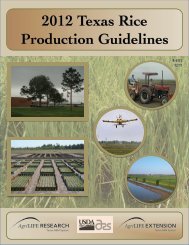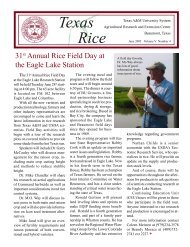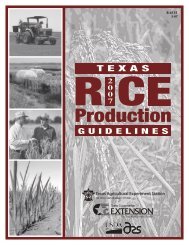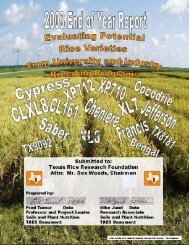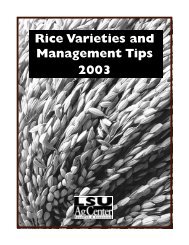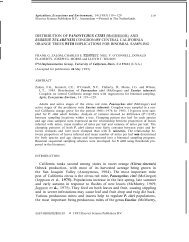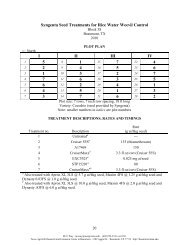Texas Rice - Texas A&M AgriLIFE Research Center at Beaumont ...
Texas Rice - Texas A&M AgriLIFE Research Center at Beaumont ...
Texas Rice - Texas A&M AgriLIFE Research Center at Beaumont ...
Create successful ePaper yourself
Turn your PDF publications into a flip-book with our unique Google optimized e-Paper software.
Found<strong>at</strong>ion Seed continued...<br />
tain the purity of the seed rice. The combines are thoroughly<br />
disassembled and cleaned after each variety is<br />
harvested, removing the header and all the screens, to<br />
insure th<strong>at</strong> cross contamin<strong>at</strong>ion does not occur.<br />
In the 2001 crop year Saber, Jefferson, Bolivar,<br />
Lemont and Della were produced by the found<strong>at</strong>ion<br />
seed program. A commercial field of Dixiebelle was<br />
also produced. The TRIA board will meet in January<br />
to decide which varieties will be grown in 2002, but<br />
indic<strong>at</strong>ions are the list will include<br />
Saber, Bolivar, Jasmine 85, Cypress<br />
and Cocodrie.<br />
The deadline for placing<br />
found<strong>at</strong>ion seed orders is January<br />
18 th . If the pre-deadline orders for<br />
a variety exceed the supply available,<br />
then the seed will be alloc<strong>at</strong>ed<br />
by the TRIA board. After<br />
the January 18 th deadline, remaining<br />
seed is distributed on a first<br />
come, first served basis. It is to<br />
the grower’s advantage to order<br />
Kip Landry first started <strong>at</strong> the <strong>Beaumont</strong><br />
<strong>Center</strong> in 1994, and has worked in the<br />
Found<strong>at</strong>ion Seed Program for the past two<br />
years. Not pictured is Louis Perez, who has<br />
worked in the program since the fall of 2000.<br />
6<br />
early, to insure they will get wh<strong>at</strong><br />
they need for th<strong>at</strong> crop year. Only<br />
those producers who particip<strong>at</strong>e<br />
in the rice check-off program are<br />
eligible to purchase found<strong>at</strong>ion<br />
seed.<br />
The check-off program was initi<strong>at</strong>ed in 1982 as<br />
authorized by st<strong>at</strong>e law, and the monies are collected<br />
by the <strong>Texas</strong> <strong>Rice</strong> Producers Board (TRPB). Each year,<br />
farmers contribute 8¢ per every hundredweight of rice<br />
sold, with 5¢ directed towards research and 3¢ for marketing.<br />
The TRPB collects the check-off fund and distributes<br />
the money earmarked for marketing to the<br />
<strong>Texas</strong> <strong>Rice</strong> Council and the research funds to the <strong>Texas</strong><br />
<strong>Rice</strong> <strong>Research</strong> Found<strong>at</strong>ion (TRRF), who then awards<br />
the money to researchers through a competitive grant<br />
program. TRRF is also a voluntary non-profit organiz<strong>at</strong>ion,<br />
solely comprised of farmers. The Chairman of<br />
TRRF is Des Woods, Vice-Chairman is Layton Raun,<br />
and the secretary is Rodney Mowery. Alice Garlough<br />
is a registered CPA and acts as Administr<strong>at</strong>ive Services<br />
Manager for the organiz<strong>at</strong>ion. Her office is loc<strong>at</strong>ed<br />
on their family ranch just outside of Sealy in C<strong>at</strong><br />
Spring. She works for TRRF on a contract basis, and<br />
handles all the bookkeeping associ<strong>at</strong>ed with the collection<br />
and distribution of check-off funds. At the end<br />
of the year, farmers have the option of requesting a<br />
refund, or leaving their check-off monies in place to<br />
be distributed by TRRF. The call for proposals goes<br />
out in the Fall, and each December researchers can<br />
submit grant proposals dealing with rice production<br />
and improvement. The review process goes through<br />
February, <strong>at</strong> which time the TRRF Board of Directors<br />
announces which proposals have been awarded funding.<br />
Last year the <strong>Texas</strong> <strong>Rice</strong> <strong>Research</strong><br />
Found<strong>at</strong>ion funded<br />
$600,886 in grant and equipment<br />
money, all of which came from producer<br />
check-off funds. Since its<br />
conception in 1982, the TRRF<br />
board has distributed over $15 million<br />
for rice research in <strong>Texas</strong>.<br />
Projects funded last year include<br />
Biology and Management of<br />
Stem Borers in the <strong>Texas</strong> <strong>Rice</strong> Belt;<br />
Determining the Physical, Chemical<br />
and Genetic Mechanisms of<br />
Fissure Resistance; Development<br />
of Improved Breeding Methods<br />
and <strong>Rice</strong> Cultivars for <strong>Texas</strong>; Farm<br />
Level Analysis for the Evalu<strong>at</strong>ion<br />
of Farm Policy Options; Funding<br />
of 2002 <strong>Rice</strong> Production Guidelines<br />
and <strong>Rice</strong> Upd<strong>at</strong>e Newsletter; Integr<strong>at</strong>ed Weed<br />
Management System for Herbicide Tolerant <strong>Rice</strong>;<br />
Physiology <strong>Research</strong> to Improve Combined First and<br />
Second Crop Yield; The Physiological Basis for Superior<br />
Yield Performance in <strong>Texas</strong> <strong>Rice</strong>; A Rapid<br />
Method for Determining Carbohydr<strong>at</strong>es and Nitrogen<br />
<strong>at</strong> Different Stages of <strong>Rice</strong> Development; <strong>Rice</strong> Growth,<br />
Development, and Yield Educ<strong>at</strong>ional Series and Survey<br />
for Current <strong>Texas</strong> <strong>Rice</strong> Crop St<strong>at</strong>istics; and Stem<br />
Carbohydr<strong>at</strong>es <strong>Research</strong> to Expand R<strong>at</strong>oon Crop Acreage<br />
and Income.<br />
In spite of the reduction in <strong>Texas</strong> rice acreage over<br />
the past 10 years, the industry continues to contribute<br />
a significant amount to the st<strong>at</strong>e’s economy. Now more<br />
than ever before, it is important for producers and researchers<br />
to strengthen alliances, and reaffirm commitments<br />
th<strong>at</strong> will carry the rice industry forward into<br />
the 21 st century.<br />
*<br />
Article and photos by Jay Cockrell.



